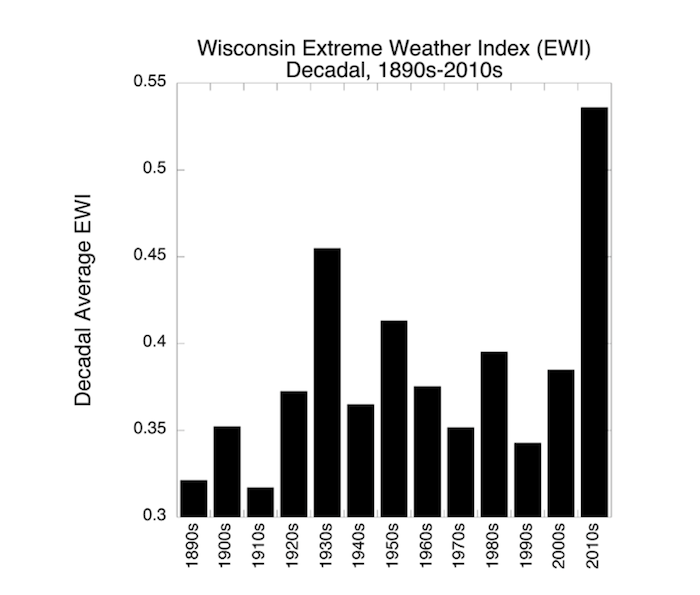Extreme Weather Events in Wisconsin
The Wisconsin Initiative on Climate Change Impacts projects Wisconsin will experience more extreme weather events in the future. This projection may not be surprising, given the State just dealt with a drought in 2023, followed by abundant rainfall and localized flooding events in spring 2024, and is now back into dry conditions this fall. These extreme weather events delayed timely field operations (e.g., crop planting), altered growing seasons, and negatively affected farm economics. Extreme weather events are becoming the “new normal” instead of isolated events.
The Extreme Weather Index shows a clear spike during the 2010s and a secondary peak during the 1930s Dust Bowl. Source: Steve Vavrus, Wisconsin State Climatology Office
How can cover crops affect drought resilience?
Cover crop termination timing and residue retention can be used to adapt to drought by adjusting cover crop water use and reducing soil water evaporation, respectively. Adaptive management of cover crop termination in the spring can improve drought resilience. If conditions are dry in the spring, farmers should terminate cover crops early to allow for water recharge and offset water depletion before planting cash crops. Cover crop residues on the soil surface can contribute to drought resilience by reducing soil water evaporation and regulating soil temperature. Cover crop residue may be more effective at conserving soil water under relatively mild or moderate droughts than in more severe conditions. While specific research on how cover crops affect drought resilience is still limited, a field experiment that imposed drought conditions on corn-based rotations in a temperate environment showed that adding a red clover cover crop to the rotation enhanced corn drought resistance, maintained yields, and reduced drought-induced losses in crop yield by over 17% (Renwick et al., 2021). Cover crop effects on soil properties like aggregate stability, macroporosity, organic matter concentration, and water infiltration could help cash crop roots access water at deeper depths and are also potential long-term drought adaptation strategies.How can cover crops capture flood waters?
Flooding risks could increase due to the localized and intense rainfall events projected to occur more frequently in Wisconsin. Management decisions that increase soil compaction and reduce infiltration can also heighten risks for flooding. Cover crops can mitigate flooding risks by taking up excess soil water and improving soil physical properties.Cover crops can capture and use excess water during the period between cash crops. Soil water consumption by cover crops can be a problem in drought years, but it can be highly beneficial in wet years, especially in flood-prone fields. Cover crops can dry out waterlogged soils faster, allowing for more timely field access. In fields with tile drainage systems, cover crops can be a companion practice to reduce excess water and flooding risks while simultaneously absorbing excess nutrients and reducing nonpoint source pollution.Cover crops can also mitigate flood risks by increasing water infiltration and improving other soil hydraulic properties. It can take several years of cover cropping for these soil hydraulic properties to shift, but deep-rooted cover crops (e.g., brassicas) can open up compacted layers and increase water infiltration to deeper layers in the soil profile in the short-term. While cover crops can help the management of waterlogged or moderately flooded soils, extended floods can limit their effectiveness.How can cover crops help with extreme precipitation?
More frequent and intense heavy rain events are projected to impact Wisconsin soils. These events can delay field operations, result in replanting, and cause erosion that removes soil and nutrients from fields. Cover crops can armor and protect the soil during intense rainfalls in at least three ways. First, cover crops (canopy and residues) can intercept raindrops and buffer their erosive impact. This is one way that cover crops can reduce soil crusts compared to bare soil, thus improving infiltration. Second, soils with a history of cover crops typically have higher aggregate stability and organic matter concentrations that are more resistant to intense rainfall’s erosive energy. Third, cover crop roots hold and stabilize soils, reducing concentrated runoff that causes rill and gully erosion. Cover crop species that overwinter can mitigate erosion and flood risks in the spring more than non-winter hardy species. Data from studies in Wisconsin show winter rye cover crops can reduce runoff on an 8-15% soil slope and 2.2% soil slope by 54% and 89%, respectively, under simulated high intensity rainfall (Grabber and Jokela, 2013; Siller et al., 2016). Like other soil ecosystem services, the ability of cover crops to mitigate the effects of extreme rainfall events can be limited if aboveground and belowground biomass production is minimal.How can cover crops help with extreme temperatures?
Temperature changes, especially higher nighttime summer temperatures and increased temperatures during late fall through early spring, are projected to impact Wisconsin agricultural soils. Can cover crops buffer extremes in soil temperatures? On a daily basis, soils under cover crops are cooler during the day and warmer at night relative to soils with no cover crops. On a seasonal basis, soils under cover crops are warmer in winter and cooler during the rest of the year. Cover crops can also decrease the amplitude of day and night temperatures more than average temperatures resulting in less temperature variability. The influence of cover crops on soil water dynamics also alters soil thermal properties that play a role in stabilizing soil temperatures and minimizing the potential adverse effects of extreme soil temperature swings.
Table 1. Ways in which cover crops can help agricultural soils develop resilience and adaptation to extreme weather events (Adapted from Blanco, 2023)




Post a comment
Report Abusive Comment